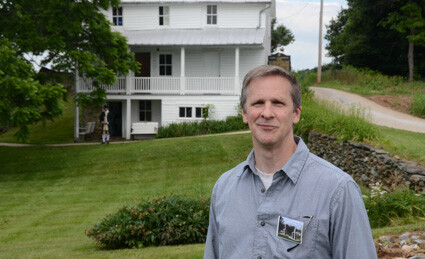
Log Meeting House at Strawbridge Shrine turns 250 (2)

by Erik Alsgaard
UMConnection Staff
In 1764, Robert Strawbridge and his fledgling Methodist Society built a Meeting House in the fields of Maryland in what was then eastern Frederick County. Made of logs, the Meeting House became the first place of worship for Methodists in America.
Last month, 250 years later, United Methodists gathered near the site of that Meeting House to celebrate and remember a proud heritage. As a men’s barbershop chorus serenaded guests and the smells of fried chicken and fish wafted over a large tent, people listened and learned about United Methodist history that’s right in their back yard.
“What did it take to travel an ocean and come to what was then a frontier land and build a meeting house by hand,” said John Strawbridge, a sixth or seventh great-grandson of Robert. As the communications coordinator for the Shrine and a member on the Board of Directors, he was present at the celebration to give tours and the history of the Shrine to guests.
“The cathedral of Methodism is a farm house or a log house,” he said. “That’s the image of Methodism that I want people to leave here with. It’s a sleeves rolled up, get your hands dirty and get out in the field kind of denomination.”
Strawbridge and his wife, Elizabeth, immigrated to the Colonies from Ireland in 1760. How they ended up in what is now Carroll County, Maryland, is somewhat of a mystery.
The Strawbridges rented 50 acres from John England. Records indicate that he had business interests in Annapolis at the time. Records also show that the Strawbridges landed in Annapolis when they arrived.
“It was not a denomination when they came here,” said Helen Kemp, Curator of the Shrine. “It was a movement.”
Robert Strawbridge preached throughout the Colonies, she said, from New Jersey to what is now West Virginia, from the Eastern Shore of Maryland to central Virginia, all of it ridden on horseback. While he was out preaching, Elizabeth tended the home, which visitors can walk through today.
Elizabeth Strawbridge is credited with the first Methodist convert in America. Kemp said that Elizabeth would share the Gospel with workers who came to help out on the farm. One of the workers, John Evans, a Quaker, heard Elizabeth and gave his life to Jesus and embraced the Methodist movement. John England, the landowner, converted to Methodism under the hand of Robert Strawbridge, who is also credited with the first Methodist baptism in America, even though he was not ordained.
“He was the only one out there in the wilderness, preaching the Gospel,” said Kemp. “He knew that people also needed Holy Communion and baptism.”
Kemp said that an ordained person couldn’t be counted on in those days, since the only ordained Protestants were Church of England priests and anti-England sentiments were running high. Strawbridge took it upon himself to administer the sacraments, even though, technically, he wasn’t supposed to.
“He saw the need and did it,” Kemp said. “Francis Asbury wrote to John Wesley about this, and Wesley replied to tell him to stop, now. Asbury did; Robert did not. He just went on doing what he did.”
Eventually, Methodism being nothing if not a movement of compromise, especially in its early days, Asbury wrote that Strawbridge was the only lay person authorized to administer the sacraments.
Robert Strawbridge died in Baltimore in 1781, at the age of 49, which Kemp said was old for a Circuit Rider. Elizabeth died in 1791, and they are both buried at Mt. Olivet cemetery in Baltimore in what is called the Bishop’s Lot.
“It’s remarkable to be at a place that you know your relatives lived in and worked in and raised a family,” said John Strawbridge as he stood in front of the house his great-great-great-great-great-great grandparents lived in. “It’s a place where you can trace your roots directly back.”
The site reminds him that the people of The United Methodist Church are all the spiritual descendants of Robert Strawbridge. As he sees confirmation classes come through the site, the visitors and guests and how they connect with it, he’s keenly aware of the importance of this place.
“It really makes you appreciate, as a descendant, that it’s not just my history, it’s all of our histories,” he said. “It’s the thing that connects us as Methodists.”

Login/Register to leave comment